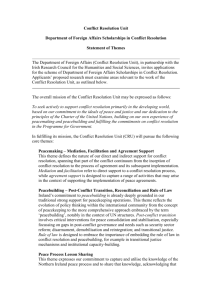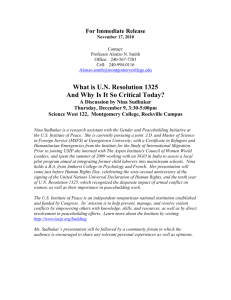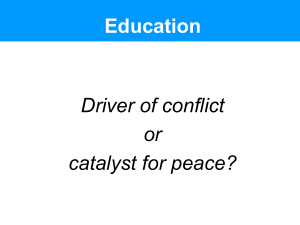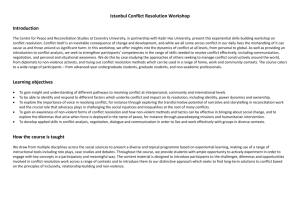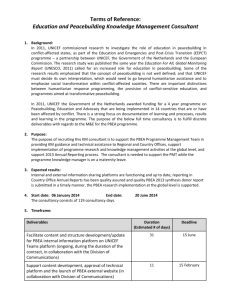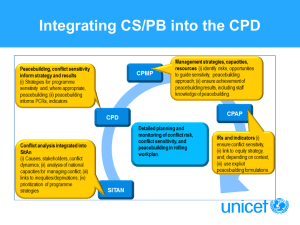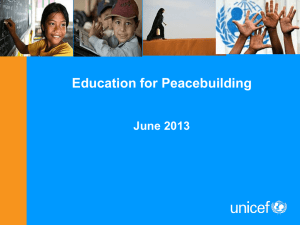File
advertisement
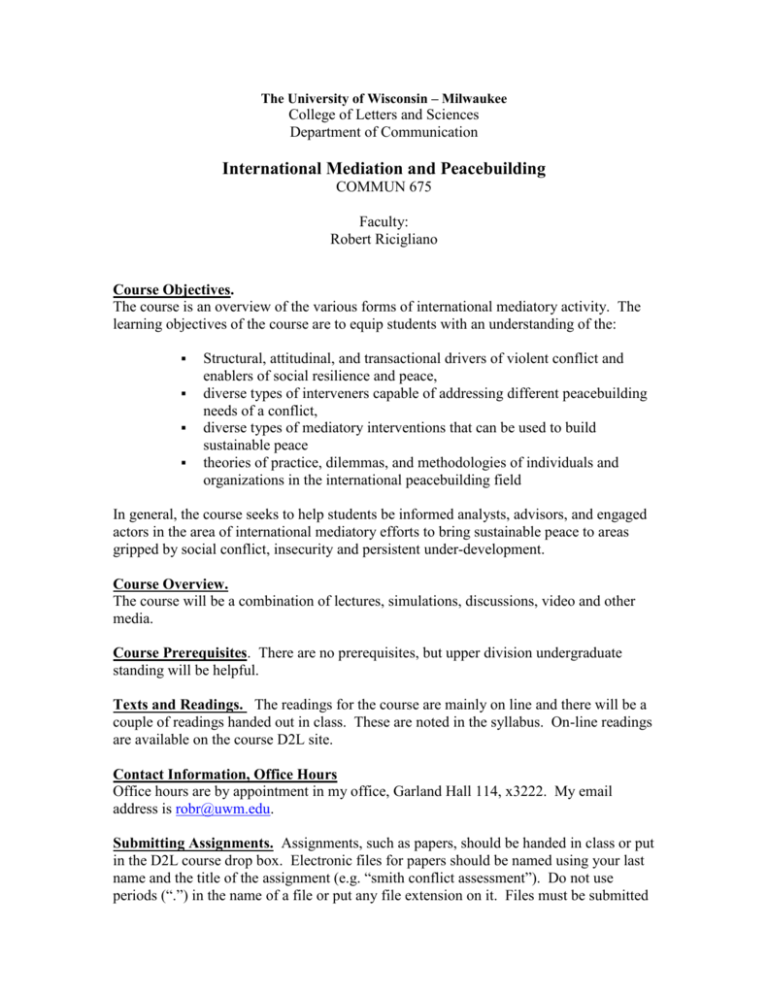
The University of Wisconsin – Milwaukee College of Letters and Sciences Department of Communication International Mediation and Peacebuilding COMMUN 675 Faculty: Robert Ricigliano Course Objectives. The course is an overview of the various forms of international mediatory activity. The learning objectives of the course are to equip students with an understanding of the: Structural, attitudinal, and transactional drivers of violent conflict and enablers of social resilience and peace, diverse types of interveners capable of addressing different peacebuilding needs of a conflict, diverse types of mediatory interventions that can be used to build sustainable peace theories of practice, dilemmas, and methodologies of individuals and organizations in the international peacebuilding field In general, the course seeks to help students be informed analysts, advisors, and engaged actors in the area of international mediatory efforts to bring sustainable peace to areas gripped by social conflict, insecurity and persistent under-development. Course Overview. The course will be a combination of lectures, simulations, discussions, video and other media. Course Prerequisites. There are no prerequisites, but upper division undergraduate standing will be helpful. Texts and Readings. The readings for the course are mainly on line and there will be a couple of readings handed out in class. These are noted in the syllabus. On-line readings are available on the course D2L site. Contact Information, Office Hours Office hours are by appointment in my office, Garland Hall 114, x3222. My email address is robr@uwm.edu. Submitting Assignments. Assignments, such as papers, should be handed in class or put in the D2L course drop box. Electronic files for papers should be named using your last name and the title of the assignment (e.g. “smith conflict assessment”). Do not use periods (“.”) in the name of a file or put any file extension on it. Files must be submitted in Word. It is your responsibility to submit papers in a readable format (Word or Word compatible). If you are unable to use either the D2L drop box or hand in a hard copy of an assignment, and you choose to email it, it is not considered handed in until you get an email confirmation from me. If an email does not make it through to my email or if it is unreadable, the paper is considered not to be submitted. In any event, students should keep either paper or electronic copies of all assignments submitted. Course Assignments and Evaluation Procedures Class Attendance and Participation. As indicated earlier, EVERY student should be prepared for EVERY class session and make a significant contribution to our discussions. If a student misses a class or is unprepared, it will not only negatively affect that person, but will also directly affect the learning of others who would have been working with the absent student in a role-play or team exercise. Of course, there are emergencies and illnesses that require students to miss class. When this occurs, students are required to give as much advance notice as possible, both to the instructor and to any classmates that might be affected. Course sessions will typically include some presentation of key concepts, exercises or case studies, and discussion. As such, attendance and participation will account up to 200 points. Points for exercises are based on the quality of your preparation for these assignments and the quality of your participation in class. Points for discussion will be based on such factors as use of the assigned readings for a particular class, relevance to the topic covered, ability to comprehend and build on contributions of other classmates, ability to effectively articulate personal experiences relevant to the discussion topic, and addition of new information or insights. Evaluation of written work All written assignments in the course will be evaluated based on the following criteria: Well-written – the paper has a clear structure, logical flow, and uses concise language and good grammar. The paper should have a clear, easy to navigate, structure with section headings (and page numbers!), Provides concise historical background – it provides essential background that is relevant to the purpose of the paper without being unnecessarily wordy. As a general rule, information about the conflict should be included in your descriptions of the report’s analysis (e.g. what are the important structural drivers) and not in the introduction. Papers that start with long historical narratives are almost always scored less highly than ones that may contain the same amount of historical narrative, but present that narrative as part of their analysis. Responsive – the paper responds to the specific task(s) described in the assignment for that paper. Insightful – the paper is able to identify the most important barriers to peace, and (most importantly) provides a rational as to why these factors are so important. 2 Asserting a particular dynamic or factor is important to building peace is not as insightful as explaining why that factor is so important. Well-founded. The paper should cite credible (e.g. accurate and impartial or at least balanced) sources for the information cited in the paper. Assignments (1) Social System Description Prepare a description of the “Social System” that you will use for your Systemic Peacebuilding Assessment (see below) and your Program Evaluation (see below). A social system can be a country in conflict, a country struggling with chronic poverty or other peacebuilding challenge. It can also include a cross border issue, like insecurity on central Africa or even a global issue like global warming. CAUTION: the bigger the issue you chose to focus on, the harder it will be to do a good analysis. The Social System description should be no more than 1 page for undergraduates (worth up to 50 points) and no more than 3 pages for graduate students (worth up to 100 points). The undergraduate Social System Description should include: A description of the social system to be analyzed. If you are not using a country as the unit of your analysis, you need to be explicit about how you are defining the boundaries of your social system. For example, if you choose an issue like global warming, are you looking at a specific region or is your unit of analysis global? Globally defined issues will be particularly difficult to analyze in this course. At least three sources (e.g. reports, articles, books) on the social system and/or peacebuilding challenges that you will use as important sources of information. Provide a one sentence description of each source. Websites are not acceptable as one of the three sources you indentify in this paper. The graduate Social System Description should include the same elements as the undergraduate Social System Description, plus the following: Identification of the peacebuilding challenges that you see in your social system (e.g. violence, persistent poverty, insecurity, etc.), Identify three organizations that are working in this social system or on the peacebuilding challenges you identified (e.g. UN agencies, non-governmental organizations, local organizations). (2) Midterm Quiz The Midterm is an on-line, take-home test. The midterm will be posted on the D2L site by 7:00 AM the day of the midterm and must be put turned in (see rules for submitting assignments above) by 11:00 pm that same day. The midterm will count for up to 100 points. (3) SAT Analysis Paper Prepare an analysis of the structural, attitudinal, and transaction factors, as part of a systemic peacebuilding assessment (SPA), on the social system that you have chosen. 3 The purpose of the SAT Analysis is to provide the reader with a succinct, complete, and insightful understanding of the key drivers of the peacebuilding challenges within the social system you select. You should assume that the reader of your report is a considering some sort of intervention in the social system/peacebuilding challenges you selected and will use the report to help determine what to do and how. The report should be between 6-8 pages (not counting worksheets (see below) and 10-12 pages for graduate students (not including worksheets) and help the reader understand the structural, attitudinal, and transactional drivers of a particular social system. Your analysis should be based on the frameworks presented in the course for understanding the structural, attitudinal and transactional driver of violence/peace. Your report should include: Section 1: A concise description of your social system and the peacebuilding challenges it presents. Sections 2-4: A section describing the structural barriers to peace, a section describing the attitudinal barriers to peace, and a section describing the transactional barriers to peace. These three sections should be based on “filled in” worksheets you will be given for each of the three categories (e.g. a structural assessment worksheet, an attitudinal one, and a transactional one). The assessment worksheets do not count toward your page limit. Section 5: A section identifying what you think are the primary (first tier) barriers to increasing the social system’s level of peace and an explanation of why. The SAT analysis is worth up to 200 points for under graduates and 250 points for graduate students. (4) Systems Diagram Paper Based on the SAT analysis you did on your social system (assignment 2), prepare a systems diagram of your social system with a narrative explanation. The class materials will explain how to do a systems diagram. Your systems diagram paper should include (these components will be described in class and in the readings): the diagram itself, a narrative of how they affect each other, and A list of “pivot points” for change and a change profile This paper should be 5 pages in length for undergrads and 7 pages in length for graduate students. This assignment is worth up to 150 points for undergraduates and 200 for graduate students. (5) Program Planning Quiz The Program Planning Quiz is an on-line, take-home test. The Quiz will be posted on the D2L site by 7:00 AM the day of the midterm and must be put turned in (see rules for submitting assignments above) by 11:00 pm that same day. The midterm will count for up to 100 points. (6) Final Paper: Program Evaluation Paper 4 The purpose of the assignment is to use your 2 SPA papers (assignments 2 and 4) to evaluate how to improve the potential for a specific peacebuilding program to make a contribution to Peace Writ Large (PWL). The particular methodology for doing this will be covered in class. The evaluation should include: A description of the peacebuilding program you will be evaluating. To select a program, identify a peacebuilding organization that is working in the social system you have selected (from assignment 1). Pick one of their programs (based on a description of their program from their organizational literature, web site, report, etc.). Be sure to select a program that clearly sets out what its intended programs impacts are. Using the Systems Diagram you prepared for assignment 4, do a “pathways analysis” describing the intended connection between the target program and the level of peace in the social system you have chosen. Provide recommendations for how the target program can: o Be more holistic, o Harness positive interdependence, and o Counter negative interdependence Identify key questions that need to be answered in order to improve the effectiveness of the program in the future The paper should be 6-8 pages for undergraduates, and 10-12 pages for graduate students. The paper is worth up to 200 points for undergraduates and 250 points for graduates. Summary of Assignments and Points Available Assignment Due Date UG Points Available G Points Available Percent of Total (UG/G) Attendance and Participation Throughout course 200 200 20% / 17% (1) Project Description February 14 50 100 5% / 8% (2) Mid-term quiz March 7 (on line) 200 250 20% / 21% (3) SPA: SAT Paper March 31 100 100 10% / 8% (4) Systems Diagram April 15 150 200 15% / 17% (5) Program Planning Quiz April 25 100 100 10% / 8% (6) Program Evaluation Total May 20 200 1000 250 1200 20% / 21% Grading Scale A = 93-100% B+ = 87-89% C+ = 77-79% D+ = 67-69% A- = 90-92% B = 83-86% C = 73-76% D = 63-66% B- = 80-82% C- = 70-72% D- = 60-62% 5 F < 60% Course Outline Class 1: January 24 • THE CHALLENGE OF PEACEBUILDING • “Triumph of Evil” • Norket-Darbek Case Study • COURSE REQUIREMENTS AND OVERVIEW Readings for Next Class Making Peace Last, Chapters 1-4 (on-line) Optional: Anderson and Olson, Confronting War, p. 8-19. (on line) Class 2: January 31 • THE SAT MODEL: A SYSTEMIC THEORY OF PEACEBUILDING • Systems Thinking Exercises • Norket-Darbek, continued • Georgia-South Ossetia (introduction) Readings for Next Class Making Peace Last, Chapter 5, up and including Structural Assessment USAID, Georgia Conflict Assessment, p. 1-22 (print out and bring to class) CARE/DFID Georgia-South Ossetia Assessment, p. 19-31. (on line) Print out and bring to class (print out and bring to class) SIDA, A Strategic Conflict Analysis of the South Caucasus, p. 1-31. (on line) Print out and bring to class (print out and bring to class) Class 3: February 7 • SPA: SYSTEMIC PEACEBUILDING ASSESSMENT/STRUCTURAL ASSESSMENT • Georgia-South Ossetia Structural Assessment Exercise Readings for Next Class Making Peace Last, Chapter 5, up to and including Attitudinal Assessment Review Bar-Tal, Psychological Dynamics of Intractable Conflict (on line) Maiese, Moral or Value Conflicts (on line) Woolcock, Social Capital (handout) Class 4: February 14 ***(Assignment 1) Social System Description Due (see above for details)*** 6 SPA: SYSTEMIC PEACEBUILDING ASSESSMENT/ATTITUDINAL ASSESSMENT Georgia-South Ossetia Attitudinal Assessment Exercise Readings for Next Class Making Peace Last, Chapter 5, up to the end of the chapter Class 5: February 21 • SPA: SYSTEMIC PEACEBUILDING ASSESSMENT/TRANSACTIONAL ASSESSMENT • • Georgia-South Ossetia Transactional Assessment Exercise DIAGNOSTIC INTERVIEW SKILLS Readings for Next Class Making Peace Last, Chapter 6 (on line) Class 6: February 28 INTRODUCTION TO SYSTEMS MAPPING • Georgia-South Ossetia Headlines Exercise • Systems Mapping Exercise Readings for Next Class Making Peace Last, Chapter 7 (on line) Class 7: March 7 ***(Assignment 2) On-line Mid-term (see above for details)*** • No class meeting Readings for Next Class Continue work on Assignment 3 - SPA: SAT Paper Class 8: March 14 • SYSTEMIC MAPPING, PART 2 • Georgia-South Ossetia Mapping Exercise Readings for Next Class Continue work on Assignment 3 – SAT Paper Class 9: March 28 • SYSTEMIC PLANNING 7 Readings for Next Class Making Peace Last Chapter 7 March 31 ***(Assignment 3) SAT Analysis Paper Due (see above for details)*** Class 10: April 4 • SYSTEMIC PLANNING • Planning Exercises Readings for Next Class TBA Class 11: April 11 • SYSTEMIC INTERVENTION DESIGN • MODES OF INTERVENTION: STRUCTURAL PEACEBUILDING • Bunjabe Exercise Readings for Next Class Vora, Effectiveness of South Africa’s Truth and Reconciliation Commission (on line) Ricigliano, Problems Without a Process (on line) Lederach, Conflict Transformation (on line) April 15: ***(Assignment 4) Systems Diagram Due (see above for details)*** Class 12: April 18 • MODES OF INTERVENTION: ATTITUDINAL PEACEBUILDING • Video: Facing the Truth (South Africa’s Truth and Reconciliation Commission) • Dialogue Exercises Readings for Next Class Making Peace Last, Chapter 8 (on-line) Hottinger, The Relationship Between Track One and Track Two Diplomacy, (on-line) 8 Class 13: April 25 ***(Assignment 5) On-line Program Planning Quiz details)*** • (see above for No class meeting Class 14: May 2 • MODES OF INTERVENTION: TRANSACTIONAL PEACEBUILDING • PROGRAM EVALUATION Readings for Next Class Making Peace Last, Chapter 9 (on line) Fisher, Facilitated Joint Brainstorming Article (on line) Haysom, Engaging Armed Groups in Peace Processes: Lessons for effective practice (on-line) Class 15: May 9 • MODES OF INTERVENTION: TRANSACTIONAL PEACEBUILDING , part 2 • Course Review Final: May 20 ***(Assignment 6) Final Paper: Program Evaluation Due (see above for details)*** 9 Course Policies Classroom Behavior. The instructional staff for this course have a strong commitment to the development and maintenance of an instructional climate that supports equality of opportunity and respect for differences based on gender, culture, ethnicity, class, disability, and sexual orientation. Your enrollment in this course assumes that you will treat your fellow classmates and instructional staff with respect. Original Work Requirement. All work submitted for this course should be original work product produced for this course. You cannot submit for this class work for which you have or will receive credit in another course. Academic Misconduct. Academic misconduct will be carefully monitored in this course. Cheating on examinations or written assignments (e.g. using someone else’s material without proper citation, unauthorized collaboration on papers, etc.) will result in immediate failure of this course. Academic misconduct will be reported to the investigating Officer of the College of Letters and Sciences and additional sanctions may be recommended. Drop Policy. If you do not attend the first week of this class you may be dropped. You may drop the course with the written approval of your instructor through the date specified in the schedule of classes. After this date, drops will be permitted only for reasons of extraordinary circumstances not related to academic performance in the course. To drop this course after the specified date, you must obtain written permission from the instructor and must file a written appeal with your school/college advising office. Only if the instructor and your school/college approve will such drops be permitted. Incomplete. An incomplete may be given in lieu of a final grade if you have completed the course successfully until the end of the semester/session but, because of an illness or other unusual and substantiated cause beyond your control, you cannot complete the final paper and/or final examination. You must be able to provide the instructor with written, verifiable, and acceptable proof of medical or family emergency. This proof must clearly indicate that the emergency prevented you from completing assignments. Diasbled Students. If you have a disability, which will affect your performance in this course, you are responsible for contacting your instructor during the first week of class regarding any need for note-taking, presentational, or test-taking accommodations. Religious Observation. You will be allowed to complete graded assignments, examinations, and other course requirements at an alternative date and time if your participation in a religious observation prevents you from completing the assignment on the scheduled date. You are responsible for contacting your instructor during the second week of class regarding the need to reschedule the assignment dates. 10
